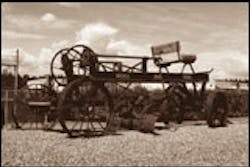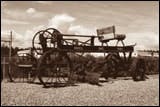The Russell Grader
In 1903 two entrepreneurs, Richard Russell and C.K. Stockland, organized Russell Grader Manufacturing in Stephen, Minn. They had already been involved in road-maintenance equipment and wanted to manufacture graders and other road-building machines to their own designs. Their first product was a horse-drawn elevating-type grader with a gasoline engine to drive the conveyor. Business prospered, and soon they were able to expand into a new factory in Minneapolis with additional manufacturing space.
New products were added including an improved two-horse pull-type blade grader in 1908. With steam and gasoline-powered tractors becoming more widely used on road construction, Russell developed larger sizes of pull-type graders suitable for most models of wheeled tractors. These required much stronger steel frames and robust construction.
Today, pull-type graders are only seen in museums or with preservation groups, but they were once a common sight on rural roads and construction projects. Because graders were mainly used for road maintenance, they were often referred to as "road patrols" or "maintainers." They possessed all the blade movements of today's modern grader, but blade control on the early machines was by hand — usually through cranks or racks and pinions operated by human muscle power. It took a crew of two to operate the grader outfit, a tractor operator and a grader operator who stood on a simple "stand" at the rear of the machine. Because hand control was tiresome and could be dangerous when the blade hit a solid object, Russell offered power controls by the early 1920s with a small gasoline engine providing the power.
By the time Caterpillar Tractor was formed in 1925, Russell had become one of the leading grader manufacturers, and because many Russell graders were using Cat tractors for their motive power, it was a natural for the two companies to unite on a corporate basis. So, in 1928, Caterpillar purchased Russell Grader Manufacturing and was then able to offer graders to complement its crawler-tractor line. This was Caterpillar's first venture into a new product line since the company's establishment three years earlier.
At first Caterpillar sold the former Russell elevating and blade grader models under its own brand name but, within a few years, completely redesigned and modernized Russell's original graders. The "No.10 Auto Patrol" of 1931 was one of the first graders with major Caterpillar input, tipping the scales at 13,460 pounds and powered by a Cat 40-hp gas engine. During the 1930s, an entire new range was developed, the forerunner of today's line of Caterpillar motor graders.
You can read more about the evolution of construction equipment in Keith Haddock's book "Giant Earthmovers an Illustrated History" available in most bookstores. Also, consider a membership in the Historical Construction Equipment Association, www.hcea.net.


